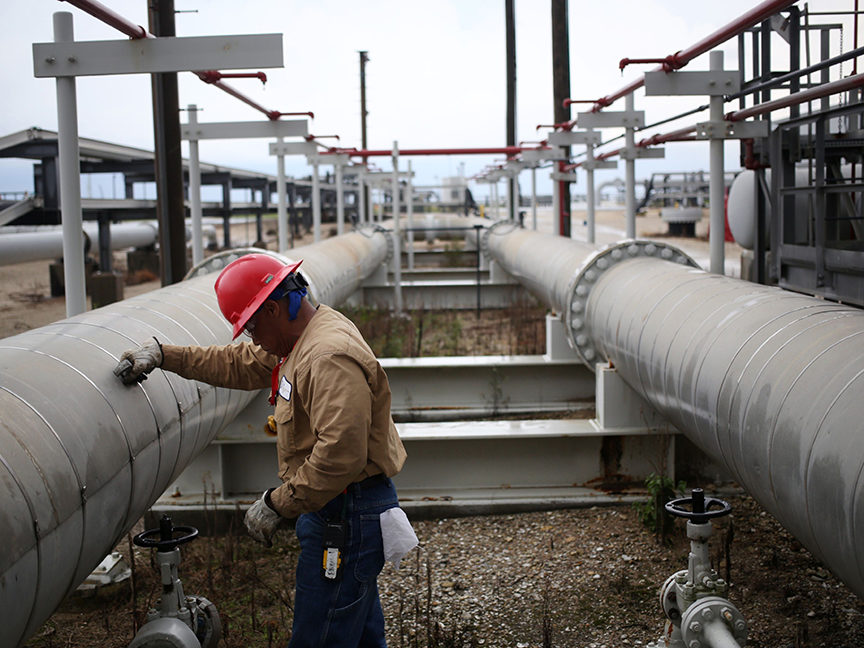
Home » U.S. Oil Plan Hinges on 1970s Reserve With Troubled History
U.S. Oil Plan Hinges on 1970s Reserve With Troubled History

April 1, 2022
The Biden administration’s mammoth drawdown of the Strategic Petroleum Reserve depends on an aging network of pipelines and oil storage tanks with a problematic past.
The reserve, the world’s largest emergency supply, was created in the aftermath of the Arab oil embargo of the early 1970s, but its distribution system was designed with a 25-year lifespan in mind and previous test sales have revealed problems that could hinder the ability to move oil quickly.
Tanks have collapsed and pipes have corroded at the reserve, which holds 568 million barrels of oil in underground salt caverns at four storage sites in Texas and Louisiana.
“It is an aging facility, the government has undertaken some upgrades, some of them are still in process,” said Ron Minsk, a former energy aide to presidents Barack Obama and Bill Clinton. Minsk added that the reserve should be able to handle the 1 million barrels a day withdrawal that Biden is seeking.
Congress in 2015 approved a $2 billion program to modernize the reserve, citing concerns about its age and condition. But a 2020 report by the Energy Department’s inspector general found that program “may not fully address” Congress’s concerns with the age and condition of the oil reserve.
Specifically, the department canceled a plan to increase the reserve’s distribution capabilities out of concern it didn’t have the congressional funding authority, and instead opted to move forward with a life extension project. The Energy Department has estimated that the project, which includes upgrading and replacing pumps, motors, piping, and and other major components, would be completed in 2025, the report said.
A 2016 Energy Department analysis found the SPR could only effectively distribute, at most, 2.56 million barrels per day, and potentially as little as 280,000 barrels per day, depending on the scenario.
The White House announced Thursday it would release roughly a million barrels of oil a day from the reserves over a six month period beginning in May, for a total of as much as 180 million barrels. It would be the largest drawdown in the history of the reserve, one that underscores White House concerns about rising gas prices and supply shortages following Russia’s invasion of Ukraine.
“Given that there are four locations, I do not anticipate an issue,” said Andy Lipow, president of Lipow Oil Associates LLC in Houston. There are currently five oil terminals that handle the four caverns’ supply, so deliveries will be manageable, he added.
While there is no question the Energy Department will be able to withdraw the oil, the wear and tear of the extraction process, which essentially involves injecting brine into the old salt domes to draw out the oil, could leave some of them unusable in the future, said Kevin Book, managing director of ClearView Energy Partners.
“They can get it out. The question will be what can they use some of the caverns for when they are done,” Book said. “Every time you draw down there is wear and tear, and using it as hard as it’s been used recently means whatever plans they carried out from the modernization program may require additional modernization.”
A 5 million barrel test sale in 2014 uncovered bottlenecks in the system, and in 2005, when the department sold 20.8 million barrels to cushion the market after Hurricanes Katrina and Rita, it took 20 days to start moving oil. But traders have said they haven’t seen any issue with previous releases ordered by the Biden administration to address high gas prices.
It isn’t just logistical challenges that traders in the market are worried about. Buyers have reported quality issues with SPR oil in recent years. American energy giant Exxon Mobil Corp.’s purchase of reserve oil in 2018 “extremely high levels” of hydrogen sulfide. In some cases, the gas level was 250 times higher than government safety standards allow. Shell Plc, Macquarie Group Ltd and PetroChina Co. had similar complaints.
While hydrogen sulfide occurs naturally in crude, producers often take pains to remove it because it can put workers at risk and corrode pipelines and refineries. Many pipelines have capped the permitted amount of hydrogen sulfide, or H2S, at 10 parts per million.
RELATED CONTENT
RELATED VIDEOS
Subscribe to our Daily Newsletter!
Timely, incisive articles delivered directly to your inbox.
Popular Stories
-

-

Diversifying Production From China: Welcome to ‘The Great Reallocation’
-

U.S. Fleet Professionals Look Toward Sustainability to Cut Down on Rising Operating Costs
-

Next-Generation Packaging Brings Reliability and Visibility to Supply Chains
-

E-Commerce Boom: Easing Supply Chain Pressure with Omnichannel Supply Chains

2024 Supply Chain Management Resource Guide: There's Only One Way Off a Burning Platform
VIEW THE LATEST ISSUECase Studies
-
Recycled Tagging Fasteners: Small Changes Make a Big Impact
-

Enhancing High-Value Electronics Shipment Security with Tive's Real-Time Tracking
-

Moving Robots Site-to-Site
-
JLL Finds Perfect Warehouse Location, Leading to $15M Grant for Startup
-
Robots Speed Fulfillment to Help Apparel Company Scale for Growth